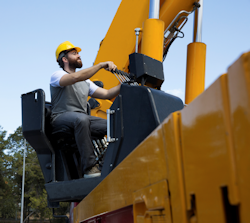Crane Operator Responsibilities
Crane operators should be certified before they can operate a crane on their own. There are generally two options for certification:
- certification by a nationally accredited crane operator testing organization, or
- certification by an audited employer program.
Crane operators' responsibilities include:
- Follow the manufacturer's procedures for operating the crane and the attachments.
- Keep the operator's manual and all procedures for operating the crane (such as load charts, recommended operating speeds, and hazard warnings) in the cab and readily available.
- Don't do anything distracting, such as texting or talking on a mobile phone, while operating the crane.

- Don't leave the controls while the load is suspended.
- Before starting the engine, verify that all controls are in the proper position and workers are in the clear.
- If crane adjustments or repairs are necessary, inform, in writing, the person responsible for receiving the information and the operator on the next shift.
- Don't operate a crane beyond its rated capacity.
- Don't use a crane to drag or pull loads sideways.
- Don't let the boom and any other parts of a crane contact an obstruction.
- Don't lift loads over the front area of wheel-mounted cranes unless the manufacturer permits it.
- When handling a load that is 90 percent or more of the maximum line pull, test the brakes by lifting the load a few inches and applying the brakes; repetitive lifts of such loads need to be tested only the first time.
- Don't lower the load or the boom below the point where fewer than two full wraps of rope remain on their respective drums.
- Control the crane's rotational speed so that the load doesn't swing out beyond the radius.
- Use a tag line if necessary to prevent a load from turning excessively.
- Refuse to handle potentially hazardous loads. A crane operator concerned about hazards involving a crane can refuse to handle loads until a qualified person determines there isn't a hazard or the hazard has been corrected.
- Stop a multiple-crane lift. The crane operator and the lift director have the authority to stop a multiple-crane lift if either determines the lift can't be done according to the lift plan.
Knowledge Check Choose the best answer for the question.
2-9. What should the crane operator do when handling a load that is 90 percent or more of the maximum line pull?
You forgot to answer the question!
